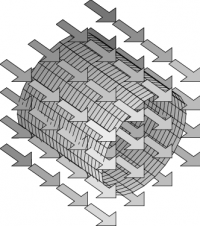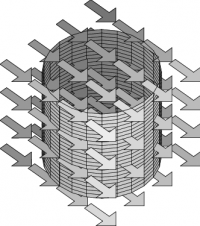You are here: start » whitepapers » sequences » flux
The Geometry of Flux
These activities are intended to address the geometric nature of flux; flux, as used in physics, is the sum of the normal components of a vector field on a surface. Gauss's law uses a flux integral to find the electric field in situations with high symmetry. The first three activities are used in rapid succession to emphasize this geometry without introducing Gauss's law explicitly and make a stand-alone introduction to the geometry of flux. The sequence culminates in using Gauss's law to find the electric field from a highly symmetric charge distribution which provides students with a physical use for flux.
Activities
 Add a description of this SWBQ.
Add a description of this SWBQ.
- Concept of Flux (Estimated time: 5 minutes): A kinesthetic activity in which students use rulers to represent a vector field while the instructor uses a hula hoop to represent a surface. The class discussion focuses conceptually on what contributes to the flux through a surface. This provides a beginning representation of the flux of a static vector field which might in contrast to some students' ideas of flux as a moving or flowing quantity. Prerequisite Knowledge: geometric concept of vector fields, vector surface element
- Calculating Flux (Estimated time: 30 minutes): In this small group activity, students calculate the flux of a simple, but non-constant, vector field through a cone. Students must find differential area elements, integrate over a surface, and understand the geometry of the given vector field and surface. The activity provides an experience in the calculation of flux without a physical context. This emphasizes the geometry and mathematics of flux calculations. This activity can be omitted if students are not expected to be able to calculate flux on complicated surfaces because the flux integral used in Gauss's law typically uses much simpler geometries because of the symmetries in charge distributions when using Gauss's law. Prerequisite Knowledge: surface integration, 3-D vector fields, differential area elements
- Visualizing Flux (Estimated time: 20 minutes): This activity uses a Mathematica (or Maple) worksheet which allows students to explore the flux of the electric field due to a point charge through the surface of a cube, a Gaussian surface. The position of the point charge can be varied, so the flux is not necessarily equal through each face of the cube. The location of the point charge can be moved both inside, outside, and on the surface of the cube which allows students to make conclusions regarding the flux though a volume containing various charge distributions. Prerequisite Knowledge: flux integrals
- Gauss's Law (Estimated time: 60 minutes): A compare and contrast activity in which students are asked to work in groups to find the electric field using Gauss's law, in integral form, for either a spherically or cylindrically symmetric charge density. Students make explicit symmetry arguments using Proof by Contradiction as part of their solution. This activity provides a physical context where flux integrals are used in order to find the electric field due to a symmetric charge density. Prerequisite Knowledge: integration of charge densities, electric fields
Homework Problems
- (FluxCubeGEM210) This problem is an easy, quick follow-up to test your understanding of fluxem activity, from Griffiths E&M book.
A charge $q$ sits at the corner of a cube. Find the flux of $\EE$ through each side of the cube. Do not do a long calculation (either by hand or by computer)!
- (FluxCylinderMHG19120) This problem is an easy, quick conceptual question about flux, from Hughes Hallett vector calculus book.
- (FluxParaboloid) This problem is a long calculation testing whether you can calculate surface elements and flux in a complicated curvilinear coordinate setting.
Find the upward pointing flux of the electric field $\Vec E =E_0\, z\, \hat z$ through the part of the surface $z=-3 s^2 +12$ (cylindrical coordinates) that sits above the $(x, y)$–plane.

